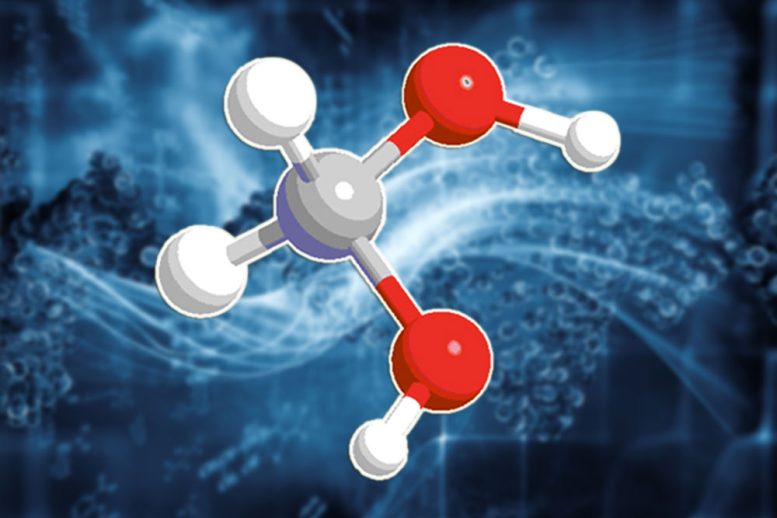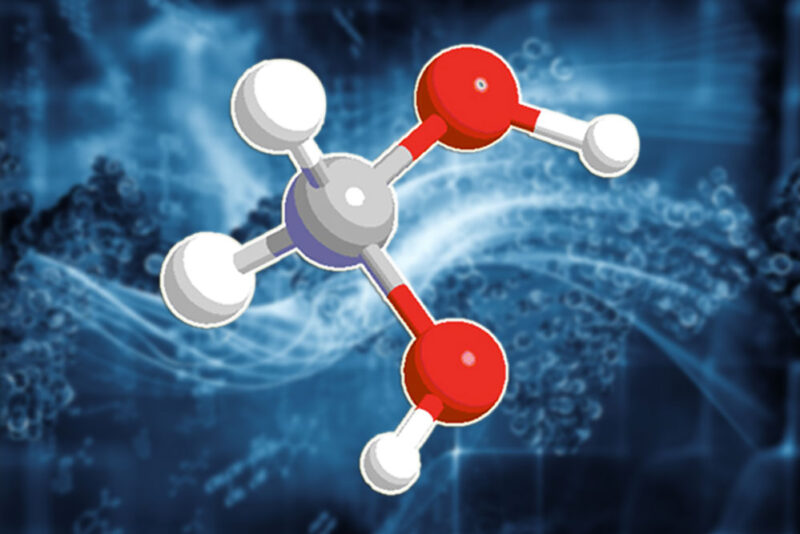
Molécule de méthanediol. Crédit : UH
La molécule de méthanediol, jusqu’alors insaisissable et importante pour les communautés de l’organique, des sciences atmosphériques et de l’astrochimie, a été produite synthétiquement pour la première fois par des chercheurs de l’Université d’Hawaiʻi à Mānoa. Leur découverte et leurs méthodes ont été récemment publiées dans Proceedings of the National Academy of Sciences.
Le méthanediol est également connu sous le nom de formaldéhyde monohydraté ou de méthylène glycol. Avec la formule chimique CH2(OH)2, c’est le diol géminal le plus simple, une molécule qui porte deux groupes hydroxyles (OH) sur un seul carbone atom. These organic molecules are suggested as key intermediates in the formation of aerosols and reactions in the ozone layer of the atmosphere.
The research team—consisting of Department of Chemistry Professor Ralf Kaiser, postdoctoral researchers Cheng Zhu, N. Fabian Kleimeier and Santosh Singh, and W.M. Keck Laboratory in Astrochemistry Assistant Director Andrew Turner—prepared methanediol via energetic processing of extremely low temperature ices and observed the molecule through a high-tech mass spectrometry tool exploiting tunable vacuum photoionization (the process in which an ion is formed from the interaction of a photon with an atom or molecule) in the W.M. Keck Laboratory in Astrochemistry. Electronic structure calculations by University of Mississippi Associate Professor Ryan Fortenberry confirmed the gas phase stability of this molecule and demonstrated a pathway via reaction of electronically excited oxygen atoms with methanol.
The findings, researchers said, advances their perception of the fundamental chemistry and chemical bonding of geminal diols and signifies their role as a key player in atmospheric and interstellar environments. Astronomers may now be able to use radio telescopes to identify elusive molecules, such as methanediol, in deep space.
This versatile strategy to first synthesize molecules, such as geminal diols, prior to their search in star forming regions, may eventually bring us closer to an understanding of the molecular structure and chemical bonding of exotic organic molecules, which according to textbooks “should not exist.” The authors are also planning the investigation of the stability and preparation of methanetriol [CH(OH)3] et le méthane tétraol [C(OH)4].
Référence : “Synthèse du méthanediol [CH2(OH)2]: The simplest geminal diol” par Cheng Zhu, N. Fabian Kleimeier, Andrew M. Turner, Santosh K. Singh, Ryan C. Fortenberry et Ralf I. Kaiser, 30 décembre 2021, Actes de l’Académie nationale des sciences.
DOI : 10.1073/pnas.2111938119



